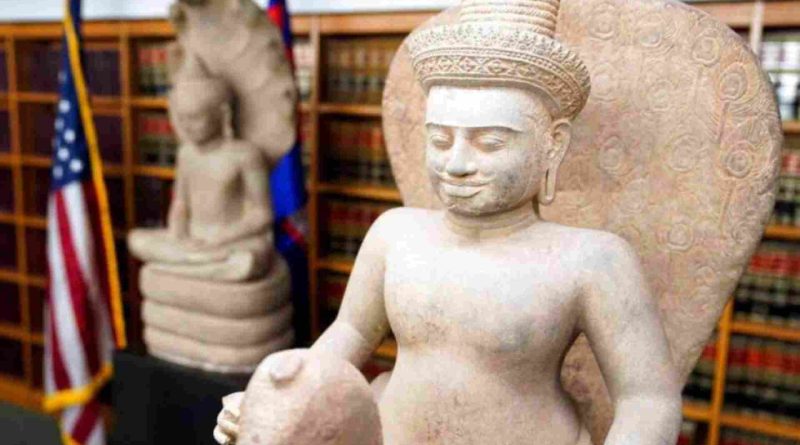Reshaping History: Cambodia’s Triumph Over Antiquities Theft
In a pivotal move, Cambodia shifts the narrative on looted artifacts, though certain losses linger beyond reparation.
The curtain rose at the close of January when the Cambodian Ministry of Culture and Fine Arts made a resounding declaration, marking a historic milestone in the realm of Southeast Asian antiquities: over a hundred prized relics from the ancient Khmer civilization, amassed over sixty years by Douglas Latchford, were to return home.
As the dust settled on Latchford’s demise in August 2020, looming federal indictments in the US underscored his alleged central role in the illicit excavation and trade of Khmer treasures from Cambodia and Thailand since the 1960s. These probes unraveled the intricate web linking the cultivation of Southeast Asian art collections in the West—gracing the halls of esteemed American cultural bastions—to the relentless pillaging of Khmer heritage on native soil. Inheriting the trove, his daughter sanctioned its spectacular repatriation. Latchford, a native Briton, orchestrated his operations from Bangkok and London, with the full extent of the family’s Khmer artifacts still veiled, purportedly divided between these two hubs.
The return, lauded by some as a benevolent gesture to Cambodia, demands a broader perspective. Rather than extolling a daughter’s disentanglement from legal quagmires, accolades are due to the relentless crusaders against antiquities looting and the clandestine networks therein: Cambodian and US authorities, scholarly circles, and advocacy groups like Chasing Aphrodite, Trafficking Culture, and Heritage Watch.
Empowered by robust provenance methods, legal frameworks, and ethical standards, the era of rampant international trafficking witnessed in Cambodia appears increasingly obsolete. Inspired by Cambodia’s strides, Thailand intensifies efforts to reclaim its looted treasures, with the imminent return of two 11th-century temple artifacts from the Asian Art Museum, San Francisco, in March. Momentum gathers for further repatriations. The scourge of plunder, ravaging Syria, Iraq, and other Middle Eastern locales under the banner of the Islamic State, has catalyzed heightened vigilance and oversight over antiquities trafficking worldwide.
The Cambodian triumph signifies a pivotal victory for advocates of stringent regulation in the global art arena. Key milestones include the belated adherence by the US Association of Art Museum Directors and the American Association of Museums to the UNESCO 1970 convention banning the illicit trafficking of cultural artifacts, and the high-profile legal showdown over Khmer “Blood Antiquities” against Sotheby’s in 2012, orchestrated by the Southern District of New York in tandem with the Cambodian government.
The resolution of the Sotheby’s case precipitated the 2014 restitution of a monumental 10th-century sculpture, violently wrenched from its pedestal at Koh Ker temple in northeastern Cambodia, where it stood for over a millennium. Court documents in the US implicated the “collector”—identified as Latchford—in purchasing the statue in the 1970s, fresh from its looting at Koh Ker, orchestrating its auction in London, and colluding with a Thai art dealer and London establishment to fraudulently secure an export permit. Thus commenced the statue’s odyssey, spanning Koh Ker to Bangkok, London, Belgium, and finally New York, where Sotheby’s stood accused of disseminating misleading provenance information to potential buyers. The ensuing publicity prompted a cascade of returns from major US museums: the Metropolitan Museum of Art, New York; Norton Simon Museum, Pasadena; Cleveland Museum of Art; and Denver Art Museum, all repatriated looted Khmer artifacts from their collections.
In his final years, Latchford courted major museums with intentions of vending the collection. Cambodia’s longstanding ban on ancient artifact exports, coupled with evolving legal and ethical paradigms, rendered this endeavor virtually unattainable. It’s within this milieu that the term “gift” must be contextualized.
It’s time to dispel the notion of Latchford as a “preeminent scholar of Khmer antiquities.” The purported “seminal reference works” appear as self-aggrandizing catalogues tailored to burnish his image and inventory. The association of certain scholars with Latchford speaks volumes about the allure of pecuniary gain and access, rather than his scholarly merit. In navigating this protracted saga, the Cambodian government has demonstrated shrewdness and magnanimity. Their offer to acknowledge “the donor” by labeling the artifacts from the “Latchford collection” at Phnom Penh’s national museum speaks volumes about strategic considerations, rather than a genuine embrace of the individual.
Now, the spotlight must shift away from Latchford towards the enduring legacy of six decades of despoilment worldwide. Artifacts dispersed via Latchford’s networks endure in the possession of international dealers, auction houses, private collectors, galleries, and museums. Meanwhile, Cambodia embarks on a new chapter.
The scars inflicted upon Cambodia by decades of plunder are indelible, exacerbating the nation’s fragility during and after the late 20th-century conflicts. Each purloined statue, every desecrated temple, dealt a crippling blow to a societal fabric woven around reverence for ancestral spirits embodied in ancient sculptures. Even upon repatriation, these artifacts cannot be reinstated in a social tapestry that has long unraveled.
Similarly, the damage to our understanding of ancient Cambodia, enshrined in situ artifacts, is irreparable. The pillage not only stripped these relics of their historical context but also fractured the narrative thread connecting them to a bygone era. While these artifacts may find sanctuary in museums once more, their capacity to enlighten us about the ancient civilization they once epitomized is severely circumscribed.
Yet, Cambodia boasts a cadre of dedicated archaeologists, conservators, and educators. With the return of these ancient Khmer relics, they are poised to undertake the Herculean task of piecing together fragments of a fractured legacy, driven by an unwavering commitment to transcend the bounds of the impossible.

